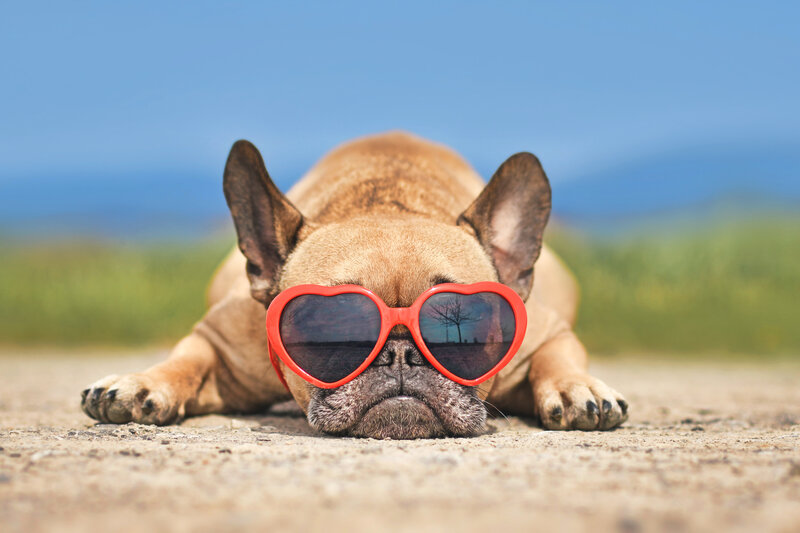
You may have heard that dogs don’t sweat - and that’s true. However, it’s hard for humans to understand the significance of that fact. Without sweat, dogs are limited in their ability to lower their core temperature, depending entirely on other cooling mechanisms: panting, the natural release of heat through their paw pads and noses, and self-selecting the coolest surfaces or environments to rest.
You put your dog’s well-being - and life - at risk each time they’re in a situation limiting their ability to take care of their cooling needs.
Thermoregulation is the scientific term describing the process of regulating body temperature. Human thermoregulation in the hot months occurs via sweating (25%) and other functions like involuntary capillaries dilating.
Dogs don’t have sweat glands and therefore rely on panting, heat release through their paws and noses, capillary dilation, and the ability to move to cooler surfaces or environments.
Unfortunately, humans seriously compromise a dog’s ability to cool off when we:
Overheating happens far quicker than we can imagine and at temperatures that may seem “just fine” to sweating humans.
Here are some quick facts about dogs and heat stroke.
Honoring the following summer safety tips for dogs support their health and can prevent the worst case imaginable: death by heat stroke.
Choosing the right breed for your lifestyle and climate is one of the least discussed topics when it comes to overall dog health. Some dogs have a harder time shedding heat via their nose and by panting - especially short-snout or “smush-faced” breeds (pugs, Boston terriers, bulldogs, etc.). Others, like Huskies or Malamutes, were bred for colder climates with coats designed to retain heat.
Breed selection is essential in many ways, from energetic/exercise needs to the lifestyles that serve them best. Resist the urge to choose a breed by looks and search for a breed or mutt that suits your daily lives, rhythms, and activities.
If your dog is left outside during the day, ensure they have all-day access to shade. If you have a patio or small yard, this may mean installing a shade sail or purchasing a large outdoor patio umbrella and a sturdy stand. Then watch their space during days off to ensure there aren’t a few hours here or there where the shade goes away - and adjust accordingly.
If you bring your dog to the park or on outdoor outings, odds are they have to be leashed. That means they depend on you to pay attention to the temperature of outdoor surfaces to reduce the risk of burnt paws and to offer shady resting spots whenever possible.
Your dog should always have access to cool fresh water at all times. This cools their mouth and keeps them hydrated (imagine how dry your mouth would be if you had to pant to keep cool!). If you’re on a road trip or running errands on a hot day - consider adding ice cubes to your water for extra cool-ability.
It’s better to leave your dog at home than walk or run them in peak temperature periods. Alter the daily routine and keep walks and hikes to the early morning and later evening hours when temperatures are cooler, and there’s less direct sunlight.
Also, not all dogs are made to run for long distances or go on multi-hour hikes. Check in with your vet about your dog’s ultimate exercise levels and honor those. An over-exercised dog who’s eager to please could be suffering and on the brink of heat stroke without you realizing it.
Dogs should never be left in cars when it’s warm - let alone hot. If you can’t take your dog wherever you go, your dog is safer at home (or with a pet sitter or doggy daycare facility) during the summer months. Depending on the temperature and humidity cracked windows and shady parking spots might not be enough to keep them safe. On a 70°F day, your car’s temperature elevates by 40°F in a very short amount of time - and temperatures continue to rise. Especially with the windows closed. That puts your dog in the 111°F danger zone much faster than you’d think.
Pet paws are a source of cooling. So, if you’re walking your dog on cement or asphalt (black asphalt can be torture), the odds are their paws are overheated. In addition to being painful and potentially damaging, it also eliminates their pads’ ability to cool down.
A reliable surface temperature test for hot weather safety: Place your bare foot or hand squarely down on the surface. If you can’t hold it there comfortably for 10 consecutive seconds, it’s too hot for dog paws.
Water is a beautiful option for cooling a dog. In addition to traveling with water and a collapsible or portable bowl (which should be offered regularly), keep your eye out for opportunities for your dog to get we via a spray bottle (sprayed on the coat), sprinklers, water features, wet grass, etc., all of which can help lower their core temperature and provide cooling relief.
Would you like support choosing your next dog or with more hot weather safety tips? The trainers at Alternative Canine Training are here to help. We know first-hand that well-matched dogs and humans are the recipe for a happy, healthy, long-term relationship. Contact us, and we’ll help you choose a dog - or provide helpful tips for the dog you have - to make sure they’re protected from the summer heat.